
INSTRUCTION MANUAL
HFM-300 FLOW METER,
HFC-302 FLOW CONTROLLER
TELEDYNE
HASTINGS
INSTRUMENTS
ISO 9001
CERTIFIED

Manual: 151-082010 300-302 Series Page 2 of 31
Manual Print History
The print history shown below lists the printing dates of all revisions and addenda created for this
manual. The revision level letter increases alphabetically as the manual undergoes subsequent
updates. Addenda, which are released between revisions, contain important change information that
the user should incorporate immediately into the manual. Addenda are numbered sequentially. When a
new revision is created, all addenda associated with the previous revision of the manual are
incorporated into the new revision of the manual. Each new revision includes a revised copy of this
print history page.
Revision C (Document Number 151-032000) .................................................................March 2000
Revision D (Document Number 151-072000) .....................................................................July 2000
Revision E (Document Number 151-092002)............................................................September 2002
Revision F (Document Number 151-082005)................................................................. August 2005
Revision G (Document Number 151-032007) .................................................................March 2007
Revision H (Document Number 151-062008) ....................................................................June 2008
Revision J (Document Number 151-092008).............................................................September 2008
Revision K (Document Number 151-082009) ................................................................ August 2009
Revision L (Document Number 151-102009)............................................................... October 2009
Revision M (Document Number 151-082010)................................................................ August 2010
Visit www.teledyne-hi.com for WEEE disposal guidance.
Hastings Instruments reserves the right to change or modify the design of its equipment without
any obligation to provide notification of change or intent to change.
The instruments described in this manual are designed for Class 2 installations
in accordance with IAW/IPC standards
CAUTION:
CAUTION:
The instruments des cribed in this manual are designed for INDOOR use only.
The instruments des cribed in this manual are av ailable with multiple pin-outs.
Ensure that all electrical connections are correct.
CAUTION:

Manual: 151-082010 300-302 Series Page 3 of 31
Table of Contents
1. GENERAL INFORMATION............................................................................................................................................4
1.1. FEATURES....................................................................................................................................................................4
1.2. SPECIFICATIONS...........................................................................................................................................................5
1.3. OPTIONAL 4-20 MA CURRENT OUTPUT............................................................................................................................ 5
1.4. OTHER ACCESSORIES ......................................................................................................................................................6
1.4.1. Hastings Power supplies........................................................................................................................................6
1.4.2. Interconnecting Cables...........................................................................................................................................6
2. INSTALLATION AND OPERATION.............................................................................................................................7
2.1. RECEIVING INSPECTION ............................................................................................................................................... 7
2.2. POWER REQUIREMENTS ...............................................................................................................................................7
2.3. OUTPUT SIGNAL...........................................................................................................................................................7
2.4. MECHANICAL CONNECTIONS.......................................................................................................................................8
2.4.1. Filtering..................................................................................................................................................................8
2.4.2. Mounting ................................................................................................................................................................8
2.4.3. Plumbing ................................................................................................................................................................8
2.5. ELECTRICAL CONNECTIONS.........................................................................................................................................8
2.6. OPERATION..................................................................................................................................................................9
2.6.1. Operating Conditions.............................................................................................................................................9
2.6.2. Zero Check...........................................................................................................................................................10
2.6.3. High Pressure Operation .....................................................................................................................................10
2.6.4. Blending of Gases................................................................................................................................................. 11
2.7. OUTPUT FILTER .........................................................................................................................................................12
2.8. CONTROLLING OTHER PROCESS VARIABLES .............................................................................................................12
2.9. COMMAND INPUT.......................................................................................................................................................13
2.10. VALVE-OVERRIDE CONTROL.....................................................................................................................................13
2.11. GAIN POTENTIOMETER ..............................................................................................................................................13
2.12. TEMPERATURE COEFFICIENTS ...................................................................................................................................14
3. THEORY OF OPERATION...........................................................................................................................................15
3.1. OVERALL FUNCTIONAL DESCRIPTION........................................................................................................................15
3.2. SENSOR DESCRIPTION................................................................................................................................................ 15
3.3. SENSOR THEORY........................................................................................................................................................15
3.4. BASE.......................................................................................................................................................................... 17
3.5. SHUNT DESCRIPTION..................................................................................................................................................17
3.6. SHUNT THEORY .........................................................................................................................................................17
3.7. CONTROL VALVE.......................................................................................................................................................21
3.8. ELECTRONIC CIRCUITRY............................................................................................................................................21
4. MAINTENANCE..............................................................................................................................................................22
4.1. TROUBLESHOOTING ...................................................................................................................................................22
4.2. ADJUSTMENTS ........................................................................................................................................................... 23
4.2.1. Calibration Procedure ......................................................................................................................................... 23
4.3. END CAP REMOVAL...................................................................................................................................................23
4.4. PRINTED CIRCUIT BOARD REPLACEMENT..................................................................................................................24
4.5. SENSOR REPLACEMENT .............................................................................................................................................24
5. GAS CONVERSION FACTORS....................................................................................................................................25
6. VOLUMETRIC VS MASS FLOW.................................................................................................................................27
7. DRAWINGS AND REFERENCES ................................................................................................................................28
8. WARRANTY....................................................................................................................................................................31
8.1. WARRANTY REPAIR POLICY ......................................................................................................................................31
8.2. NON-WARRANTY REPAIR POLICY .............................................................................................................................31

Manual: 151-082010 300-302 Series Page 4 of 31
1. General Information
The Teledyne Hastings HFM-300 is used to measure mass flow rates in gases. In addition to flow rate
measurement, the HFC-302 includes a proportional valve to accurately control gas flow. The Hastings mass flow
meter (HFM-300) and controller (HFC-302), hereafter referred to as the Hastings 300 series, are intrinsically
linear and are designed to accurately measure and control mass flow over the range of 0-5 sccm to 0-10 slm
with an accuracy of better than ±0.75% F.S. at 3σ from the mean (versions >10 slm are ±1.0% F.S.) . Hastings
mass flow instruments do not require any periodic maintenance under normal operating conditions with clean
gases. No damage will occur from the use of moderate overpressures (~500 psi/3.45MPa) or overflows.
Instruments are normally calibrated with the appropriate standard calibration gas (nitrogen) then a correction
factor is used to adjust the output for the intended gas. Calibrations for other gases, such as oxygen, helium and
argon, are available upon special order.
1.1. Features
• LINEAR BY DESIGN. The Hastings 300 series is intrinsically linear (no linearization circuitry is
employed). Should recalibration (a calibration standard is required) in the field be desired, the
customer needs to simply set the zero and span points. There will be no appreciable linearity change
of the instrument when the flowing gas is changed.
• NO FOLDOVER. The output signal is linear for very large over flows and is monotonically increasing
thereafter. The output signal will not come back on scale when flows an order of magnitude over the
full scale flow rate are measured. This means no false acceptable readings during leak testing.
• MODULAR SENSOR. The Hastings 300 series incorporates a removable/replaceable sensor module.
Field repairs to units can be achieved with a minimum of production line downtime.
• LARGE DIAMETER SENSOR TUBE. The Hastings 300 sensor is less likely to be clogged due to its large
internal diameter (0.026”/ 0.66mm). Clogging is the most common cause of failure in the industry.
• LOW ∆P. The Hastings 300 sensor requires a pressure of approximately 0.25 inches of water (62 Pa) at
a flow rate of 10 sccm. The low pressure drop across this instrument is ideal for leak detection
applications since the pneumatic settling times are proportional to the differential pressure.
• FAST SETTLING TIME. Changes in flow rate are detected in less than 250 milliseconds when using the
standard factory PC board settings.
• LOW TEMPERATURE DRIFT. The temperature coefficient of span for the Hastings 300 series is less
than 0.03% of full scale/°C from 15-50°C. The temperature coefficient of zero is less than 0.1 % of
reading/°C from 0-60°C.
• FIELD RANGEABLE. The Hastings 300 series is available in ranges from 0-5 sccm to 0-25 slpm. Each
flow meter has a shunt which can be quickly and easily exchanged in the field to select different
ranges. Calibration, however, is required.
• METAL SEALS. The Hastings 300 series is constructed of Stainless Steel. All internal seals are made
with Ni 200 gaskets, eliminating the permeation, degradation and outgassing problems of elastomer O-
rings.
• LOW SURFACE AREA. The shunt is designed to have minimal wetted surface area and no un-swept
volumes. This will minimize particle generation, trapping and retention. CURRENT LOOP. The 4-20
mA option gives the user the advantages of a current loop output to minimize environmental noise
pickup.

Manual: 151-082010 300-302 Series Page 5 of 31
1.2. Specifications
Accuracy .................................................................................... < ±0.75% full scale (F.S.) at 3σ
(±1.0% F.S. for >10 slm versions)
Repeatability .............................................................................±0.05% of reading + 0.02% F.S.
Maximum Pressure........................................................................................500 psi [3.45 MPa]
(With high pressure option) 1000 psi [6.9 MPa]
Pressure Coefficient .................................................. <0.01% of reading/psi [0.0015%/kPa] (N2)
See pressure section for higher pressure errors.
Operating Temperature ....................................................0-60°C in non-condensing environment
Temperature Coefficient (zero) .................................... Maximum ±0.1%F.S./°C (from 0 to 60°C)
Temperature Coefficient (span) ..................................Maximum ±300 ppm/°C (from 15 to 50 °C)
Maximum ±450 ppm/°C (from 0 to 60 °C)
Leak Integrity ...............................................................................................<1x10-9 std. cc/s.
Flow Ranges .................................................................. 0-5 sccm to 0-25* slpm. (N2 Equivalent)
Standard Output ........................................................................... 0-5 VDC. (load min 2k Ohms)
Optional Output ............................................................................ 4 -20 mA. (load < 600 Ohms)
Power Requirements..................................................................... ±(15) VDC @ 55 mA (meters)
± (15) VDC @ 150 mA (controller)
Class 2 power 150VA max
Wetted Materials ................................................................................ stainless steel, nickel 200
Attitude Sensitivity of zero..............................................< ±0.7% F.S. for 90° without re-zeroing
{N2 at 19.7 psia (135 KPa)}
Weight ............................................................................................................1.93 lb [0.88 kg]
Electrical Connector............................................................................... 15 pin subminiature “D”
Fitting Options................... ¼” Swagelok®, 1/8” Swagelok®, VCR®, VCO®, 9/16”-18 Female thread
Face Seal to Face Seal Length................................................................1.88”(47.75 mm) VCR®
(Specifications may vary for instruments with ranges greater than 10 slpm)
1.3. Optional 4-20 mA Current Output
An option to the standard 0-5 VDC output is the 4-20 mA current output that is proportional to flow.
The 4 - 20 mA signal is produced from the 0 - 5 VDC output of the flow meter. The current loop output
is useful for remote applications where pickup noise could substantially affect the stability of the
voltage output.
The current loop signal replaces the voltage output on pin 6 of the “D” connector. The current loop
may be returned to either the signal common or the -15 VDC connection on the power supply. If the
current loop is returned to the signal common, the load must be between 0 and 600 ohm. If it is
returned to the -15VDC, the load must be between 600 and 1200 ohm. Failure to meet these
conditions will cause failure of the loop transmitter.

Manual: 151-082010 300-302 Series Page 6 of 31
The 4-20 mA I/O option can accept a current input. The 0-5 VDC command signal on pin 14 can be
replaced by a 4-20mA command signal. The loop presets an impedance of 75 ohms and is returned to
the power supply through the valve common.
1.4. Other Accessories
1.4.1. Hastings Power supplies
Hastings Power Pod power supply/display units are available in one and four channel versions. They
convert 100, 115 or 230VAC to the ±15 VDC required to operate the flow meter and provide a digital
indication of the flow rate. Interface terminals for the retransmission of the flow meter analog output
signal are located on the rear of the panel.
The Power Pod 100 and 400 models are built with controllers in mind but will work with meters as
well. The Model 40 is for flow meters only. Throughout this manual, when reference is made to a
power supply, it is assumed the customer is using a Hastings power supply. Hastings PowerPod-100 and
PowerPod-400 power supplies are CE marked, but the Model 40 does not meet CE standards at this
time. The Model 40 and PowerPod-100 are not compatible with 4–20 mA analog signals. With the
PowerPod 400, individual channels’ input signals, as well as their commands, become 4–20 mA
compatible when selected. The PowerPod-400 also sports a Totalizer feature. More information about
the Power Pods can be found on the Hastings web site. http://www.teledyne-
hi.com/products/powerpod-series.htm
1.4.2. Interconnecting Cables
Cables are available from Hastings, in various lengths, to connect from the 15 pin "D" connector on the
back of the Power Pod directly to any of the 200 series and 300 series flow instruments (including
digital versions). More information about the available cables can be found in the Power Pod 400
bulletin on the Hastings web site. http://www.teledyne-hi.com/pdfs/bulletins.htm

Manual: 151-082010 300-302 Series Page 7 of 31
2. Installation and Operation
This section contains the steps necessary to assist in getting a new flow meter/controller into
operation as quickly and easily as possible. Please read the following thoroughly before attempting to
install the instrument.
2.1. Receiving Inspection
Carefully unpack the Hastings unit and any accessories that have also been ordered. Inspect for any
obvious signs of damage to the shipment. Immediately advise the carrier who delivered the shipment
if any damage is suspected. Check each component shipped with the packing list. Insure that all parts
are present (i.e., flow meter, power supply, cables, etc.). Optional equipment or accessories will be
listed separately on the packing list. There may also be one or more OPT-options on the packing list.
These normally refer to special ranges or special gas calibrations. They may also refer to special
helium leak tests, or high pressure tests. In most cases, these are not separate parts, rather, they are
special options or modifications built into the flow meter.
Quick Start
1. Insure flow circuit mechanical connections are leak free
2. Insure electrical connections are correct (see label).
3. Allow 30 min. to 1 hour for warm-up.
4. Note the flow signal decays toward zero.
5. Run ~20% flow through instrument for 5 minutes.
6. Insure zero flow; wait 2 minutes, then zero the instrument.
7. Instrument is ready for operation
2.2. Power Requirements
The HFM-300 meter requires +15 VDC @ 55 mA, -15 VDC @50 mA for proper operation. The HFC-302
controller requires ±15 VDC @ 150mA. The supply voltage should be sufficiently regulated to no more
than 50 mV ripple. The supply voltage can vary from 14.0 to 16.0 VDC. Surge suppressors are
recommended to prevent power spikes reaching the instrument. The Hastings power supply described
in Section 1.4.2 satisfies these power requirements.
2.3. Output Signal
The standard output of the flow meter is a 0-5 VDC signal proportional to the flow rate. In the
Hastings power supply the output is routed to the display, and is also available at the terminals on the
rear panel. If a Hastings supply is not used, the output is available on pin 6 of the “D” connector. It is
recommended that the load resistance be no less that 2kΩ. If the optional 4-20 mA output is used, the
load impedance must be selected in accordance with Section 1.3.

Manual: 151-082010 300-302 Series Page 8 of 31
2.4. Mechanical Connections
2.4.1. Filtering
The smallest of the internal passageways in the Hastings 300 is the diameter of the sensor tube, which
is 0.026”(0.66 mm), and the annular clearance for the 500 sccm shunt which is 0.006"(0.15 mm) (all
other flow ranges have larger passages), so the instrument requires adequate filtering of the gas supply
to prevent blockage or clogging of the tube.
2.4.2. Mounting
There are two mounting holes (#8-32 thread) in the bottom of the transducer that can be used to
secure it to a mounting bracket, if desired.
The flow meter may be mounted in any position as long as the direction of gas flow through the
instrument follows the arrow marked on the bottom of the flow meter case label. The preferred
orientation is with the inlet and outlet fittings in a horizontal plane.
As explained in the section on operating at high pressures, pressure can have a significant affect on
readings and accuracy. When considering mounting a flow meter in anything other than a horizontal
attitude, consideration must be given to the fact that the heater coil can now set up a circulating flow
through the sensor tube, thereby throwing the zero off. This condition worsens with denser gases or
with higher pressures. Whenever possible, install the instrument horizontally.
Always re-zero the instrument with zero flow, at its normal operating temperature and purged with its
intended gas at its normal operating pressure.
2.4.3. Plumbing
The standard inlet and outlet fittings for the Hastings 300 Series are VCR-4, VCO-4 or 1/4" Swagelok. It
is suggested that all connections be checked for leaks after installation. This can be done by
pressurizing the instrument (do not exceed 500 psig unless the flow meter is specifically rated for
higher pressures) and applying a diluted soap solution to the flow connections.
2.5. Electrical Connections
If a power supply from Hastings Instruments is used, installation consists of connecting the HFM-
300/302 series cable from the “D” connector on the rear of the power supply to the “D” connector on
the top of the flow meter /controller. The “H” pin-out requires cable AF-8-AM (grey molded
backshell). The “U” pin-out requires cable # 65-791 (black molded backshell).
If a different power supply is used, follow the instructions below when connecting the flow meter and
refer to either table 2.1 or 2.2 for the applicable pin-out. The power supply used must be bipolar and
capable of providing ±15 VDC at 55 mA for flow meter applications and ±15 VDC at 150 mA for
controllers. These voltages must be referenced to a common ground. One of the “common” pins must
be connected to the common terminal of the power supply. Case ground should be connected to the
AC ground locally. The cable shield (if available) should be connected to AC ground at the either the
power supply end, or the instrument end of the cable, not at both. Pin 6 is the output signal from the
flow meter. The standard output will be 0 to 5 VDC, where 5 VDC is 100% of the rated or full scale
flow.
The command (set point) input should be a 0-5 VDC signal (or 4-20mA if configured as such), and must
be free of spikes or other electrical noise, as these would generate false flow commands that the
controller would attempt to follow. The command signal should be referenced to signal common.
A valve override command is available to the flow controller. Connect the center pin of a single pole,
three-position switch (center off) to the override pin. Connect +15 VDC to one end of the three
position switch, and -15 VDC to the other end. The valve will be forced full open when +15 VDC is
supplied to the override pin, and full closed when -15 VDC is applied. When there is no connection to
the pin (the three-position switch is centered) the valve will be in auto control, and will obey the 0-5
VDC commands supplied to command (set-point) input.

Manual: 151-082010 300-302 Series Page 9 of 31
Figures 2.1/2.2, and Tables 2.1/2.2, show the 300/302 pin out.
Pin # Pin #
1 Signal Common 1 Do not use
2 Do not use 2 Do not use
3 Do not use 3 Do not use
4 +15 VDC 4 Do not use
5 5 Signal Common
6 Output 0-5 VDC (4-20mA) 6 Output 0-5 VDC (4-20mA)
7 Signal Common 7 Case Ground
8 Case Ground 8 Valve Override
9 Valve Override 9 -15VDC
10 10 Do not use
11 -15VDC 11 +15VDC
12 External Input 12 Signal Common
13 Signal Common 13 External Input
14 Signal Common 14 Set Point 0-5 VDC (4-20mA)
15 Set Point 0-5 VDC (4-20mA) 15 Do not use
Table 2.1
"U" Pin-Out
Table 2.2
"H" Pin-Out
2.6. Operation
The standard instrument output is a 0 - 5 VDC out and the signal is proportional to the flow i.e., 0
volts = zero flow and 5 volts = 100% of rated flow. The 4 - 20 mA option is also proportional to flow, 4
mA = zero flow and 20 mA = 100% of rated flow.
2.6.1. Operating Conditions
For proper operation, the combination of ambient temperature and gas temperature must be such that
the flow meter temperature remains between 0 and 60°C. (Most accurate measurement of flow will
be obtained if the flow meter is zeroed at operating temperature as temperature shifts result in some
zero offset.) The Hastings 300 series instrument is intended for use in non-condensing environments
only. Condensate or any other liquids which enter the flow meter may destroy its electronic
components.
Fig. 2.1 Fig. 2.2

Manual: 151-082010 300-302 Series Page 10 of 31
Span Error vs Pressure
(0.026" Sensor Tube)
y = 9.8877E-11x
3
3.4154E-07x -
2
8.3288E-05x +
-20.0%
-18.0%
-16.0%
-14.0%
-12.0%
-10.0%
-8.0%
-6.0%
-4.0%
-2.0%
0.0%
2.0%
0 100 200 300 400 500 600 700 800 900 1000
Pressure(psig)
Span Error (% reading)
Mean error
max
min
2.6.2. Zero Check
Turn the power supply on if not already energized. Allow for a 1 hour
warm-up. Stop all flow through the instrument and wait 2 minutes.
Caution: Do not assume that all metering valves completely shut off
the flow. Even a slight leakage will cause an indication on the meter
and an apparent zero shift. For the standard 0-5 VDC output, adjust
the zero potentiometer located on the inlet side of the flow meter
until the meter indicates zero (Fig 2.3). For the optional 4-20 mA
output, adjust the zero potentiometer so that the meter indicates
slightly more than 4 mA, i.e. 4.03 to 4.05 mA. This slight positive
adjustment ensures that the 4-20 mA current loop transmitter is not in
the cut-off region. The error induced by this adjustment is
approximately 0.3% of full scale. This zero should be checked
periodically during normal operation. Zero adjustment is required if
there is a change in ambient temperature, or vertical orientation of
the flow meter /controller.
2.6.3. High Pressure Operation
When operating at high pressure, the increased density of gas will cause natural convection to flow
through the sensor tube if the instrument is not mounted in a level position. This natural convection
flow will be proportional to the system pressure. This will be seen as a shift in the zero flow output
that is directly proportional to the system pressure.
Fig. 2.4
Fig. 2.3

Manual: 151-082010 300-302 Series Page 11 of 31
Span Error Vs. Pressure
0.017" Sensor
-2%
-1%
0%
1%
2%
3%
4%
5%
0 100 200 300 400 500 600 700 800 900 1000
Pressure (psig)
Span Error (% reading)
Mean
Max
Min
If the system pressure is higher than 250 psig (1.7 MPa) the pressure induced error in the span reading
becomes significant. The charts above show the mean error enveloped by the minimum/maximum
expected span errors induced by high pressures. This error will approach 16% at 1000 psig. For
accurate high pressure measurements this error must be corrected.
The formulae for predicting mean error expressed as a fraction of the reading are:
)"026.0(,)10*3288.8()10*4154.3()10*887.9(
527311
26
SensorPPPError
−−−
+−=
)"017.0(,)10*8313.1()10*304.3()10*(1.533
4273-10
17
SensorPPPError
−−
+−=
)"014.0(,)10*929.1()10*776.1()10*(-1.692
5273-10
14
SensorPPPError
−−
−+=
Where P is the pressure in psig and Error is the fraction of the reading in error.
The flow reading can be corrected as follows:
Where the Indication is the indicated flow and Error is the result of the previous formula (or read from
charts above).
2.6.4. Blending of Gases
This section describes two methods by which to achieve a controlled blending of different gasses. Both
methods use the flow signal (Output) from one flow instrument as the Master to control the Command
signal (Input) to a second unit.
(
)
ErrorIndicationIndicationCorrected *
−
=
Fig. 2.5

Manual: 151-082010 300-302 Series Page 12 of 31
The first method requires that the two controllers use the same signal range (0 to 5 VDC or 4 to 20 mA)
and that they be sized and calibrated to provide the correct ratio of gasses. Then, by routing the
actual flow Output signal from the primary meter/controller through the secondary controller’s
External Input pin (See Tables 2.1 & 2.2), the ratio of flows can be maintained over the entire range of
gas flows.
EXAMPLE: Flow controller A has 0-100 slpm range with a 5.00 volt output at full scale. Flow
controller B has 0-10 slpm range with a 5.00 volt output at full scale. If flow controller A is set at 80
slpm, its output voltage would be 4.00 volts (80 slpm/100 slpm x 5.00 volts = 4.00 volts). If the output
signal from flow controller A is connected to the command Set Point of flow controller B, then flow
controller B becomes a slave to the flow signal of controller A. The resultant flow of controller B will
be the same proportion as the ratio of the flow ranges of the two flow controllers.
If the set point of flow controller A is set at 50% of full scale, and the reference voltage from flow
controller A is 2.50, then the command signal going to flow controller B would be 2.50 volts . The flow
of gas through flow controller B is then controlled at 5 slpm (2.50 volts/5.00 volts x 10 slpm = 5 slpm).
The ratio of the two gases is 10:1 (50 slpm/5slpm). The % mixture of gas A is 90.9090 (50slpm/55 slpm
and the % mixture of gas B is 0.09091% (5 slpm/55 slpm).
Should the flow of flow controller A drop to 78 slpm, flow controller B would drop to 3.9 slpm, hence
maintaining the same ratio of the mixture. (78 slpm/100slpm x 5v = 3.90v x 50% = 1.95v; 1.95v/5.00v
x 10 slpm = 3.9 slpm; 78 slpm: 3.9 slpm = 20:1)
In the blending of two gases, it is possible to maintain a fixed ratio of one gas to another. In this case,
the output of one flow controller is used as the reference voltage for the set point potentiometer of a
second flow controller. The set point potentiometer then provides a control signal that is proportional
to the output signal of the first flow controller, and hence controls the flow rate of the second gas as a
percentage of the flow rate of the first gas.
2.7. Output Filter
The output signal may have noise superimposed on the mean
voltage levels. This noise may be due to high turbulence in
the flow stream that the fast sensor is measuring or it could
be electrical noise when the flow meter has a high internal
gain. i.e. 5 sccm full scale meter. Varying levels of radio
frequency noise or varying airflow over the electronics cover
can also induce noise.
Noise can be most pronounced when measuring the flow
output with a sampling analog/digital (A/D) converter.
When possible, program the system to take multiple samples
and average the readings to determine the flow rate.
If less overall system noise is desired, a jumper may be
installed over the pins of JP-1 on the flow measurement
card. See Figure 2.6. Covering the pins closest to the “D”
connector will activate a resistor-capacitor (RC) filter that
has a time constant of one second. This will increase the
settling time of the indicated flow rate to approximately 4 seconds. Covering the other two pins will
lower the response time to approx. 1 second. This adjustment will not affect the calibration of the
flow meter circuit or the actual flow response to change in command signal (flow controllers). This
will only slow down the indicated response (output voltage/current).
2.8. Controlling Other Process Variables
Normally, a flow controller is setup to control the mass flow. The control loop will open and close the
valve as necessary to make the output from the flow measurement match the input on the command
line. Occasionally, gas is being added or removed from a system to control some other process
variable. This could be the system pressure, oxygen concentration, vacuum level or any other
parameter which is important to the process. If this process variable has a sensor that can supply an
analog output signal proportional to its value then the flow controller may be able to control this
JP-1
Fig. 2.6

Manual: 151-082010 300-302 Series Page 13 of 31
variable directly. This analog output signal could be 0-5 volts, 0-10 volts (or 4-20 ma for units with 4-
20 ma boards) or any value in between.
On the controller card there is a jumper that sets whether the control loop controls mass flow or an
external process variable. See Figure 2.7. If the jumper is over the top two pins, the loop controls
mass flow. If the jumper is over the bottom two pins, the loop controls an external process variable.
This process variable signal must be supplied on pin 12 of the D connector (for U pin out units) of the
measurement card. When the controller is set for external variable control it will open or close the
valve as necessary to make the external process variable signal match the command signal. The
command signal may be 0-5 volts, 0-10 volts (4-20 ma for 4-20 ma input/output cards) or any value in
between. If the process variable has a response time that is much faster or slower than the flow
meter signal it may be necessary to adjust the gain potentiometer.
2.9. Command Input
The flow controller will operate normally with any command input signal between 0-5 volts (4-20 ma
for units with 4-20 ma input/output cards) If the command signal exceeds ±14 volts it may damage the
circuit cards. During normal operation the control loop will open or close the valve to bring the output
of the flow meter signal to within ± 0.001 volts of the command signal. The command signal will not
match the flow signal if there is insufficient gas pressure to generate the desired flow. If the
command signal exceeds 5 volts the controller will continue to increase the flow until the output
matches the command signal. However, the flow output does not have any guaranteed accuracy
values under these conditions.
If the command signal is less than 2% of full scale (0.1 volts or 4.32 ma) the valve override control
circuit will activate in the closed position. This will force the valve completely closed regardless of
the flow signal.
2.10. Valve-Override Control
The valve override control line provides a method to override the loop controller and open or close the
valve regardless of the flow or command signals. During normal operation this line must be allowed to
float freely. This will allow the loop control to open and close the valve as it requires. If the valve
override line is forced high (> +5 volts) the valve will be forced full open. If the valve-override line is
forced negative (< -5 volts) the valve will be forced closed.
2.11. Gain Potentiometer
On the top left of inlet side of the flow controller there is a hole
through which the gain potentiometer is accessible (Fig 2.3). This
gain potentiometer affects the gain of the closed loop controller.
Normally this potentiometer will be set at the factory for good
stable control. It may be necessary to adjust this potentiometer
in the field if the system varies widely from the conditions under
which the controller was setup. Turning this gain potentiometer
clockwise will improve stability. Turning the potentiometer
counter-clockwise will speed up the valve reaction time to
changes in the command signal.
Fig. 2.7
Gain Potentiometer
Control Loop Jumper

Manual: 151-082010 300-302 Series Page 14 of 31
Fig. 2.8
2.12. Temperature Coefficients
As the ambient temperature of
the instrument changes from
the original calibration
temperature, errors will be
introduced into the output of
the instrument. The
Temperature Coefficient of
Zero describes the change in
the output that is seen at zero
flow. This error is added to the
overall output signal regardless
of flow, but can be eliminated
by merely adjusting the zero
potentiometer of the flow
meter/controller to read zero
volts at zero flow conditions.
The Temperature Coefficient of
Span describes the change in
output after the zero error is
eliminated. This error cannot
be eliminated, but can be
compensated for
mathematically if necessary.
The curve pictured in Figure 2.8
shows the span error in percent
of point as a function of
temperature assuming 23
0
C is
the calibration temperature.

Manual: 151-082010 300-302 Series Page 15 of 31
3. Theory of Operation
This section contains an overall functional description of the Hastings 300 series of flow instruments.
In this section and other sections throughout this manual, it is assumed that the customer is using a
Hastings power supply.
3.1. Overall Functional Description
The Hastings 300 meter consists of a sensor, base, and a shunt. In addition to the components in a
meter, The 300 controller includes a control valve and extra electronic circuitry. The sensor is
configured to measure gas flow rate from 0 to 5 sccm, 0 to 10 sccm, or 0 to 20 sccm, depending on the
customer’s desired overall flow rate. The shunt divides the overall gas flow such that the flow through
the sensor is a precise percentage of the flow through the shunt. The flow through both the sensor
and shunt is laminar. The control valve adjusts the flow so that the sensor’s flow measurement
matches the set-point input. The circuit board amplifies the sensor output from the two RTD’s
(Resistive Temperature Detectors) and provides an analog output of either 0-5 VDC or 4-20 mA.
3.2. Sensor Description
A cross section of the sensor is shown in Figure 3.1. The sensor consists of two coils of resistance wire
with a high temperature coefficient of resistance (3500 ppm/
o
C) wound around a stainless steel tube
with internal diameter of 0.6604 mm and 7.62 cm length. Each coil is 1.372 cm in length, and they are
separated by 1.27 mm distance. These two identical resistance wire coils are used to heat the gas
stream and are symmetrically located upstream and downstream on the sensor tube. Insulation
surrounds the sensor tube and heater coils with no voids around the tube to prevent any convection
losses. The ends of this sensor tube pass through an aluminum block and into the stainless steel sensor
base. This aluminum block thermally shorts the ends of the sensor tube and maintains them at
ambient temperature.
There are two coils of resistance wire that are wound around the aluminum block. The coils are
identical to each other, and are symmetrically spaced on the aluminum ambient block. These coils are
wound from the same spool of wire that is used for the sensor heater coils so they have the same
resistivity and the same temperature coefficient of resistance as the sensor heater coils. The number
of turns is controlled to have a resistance that is 10 times larger than the resistance of the heater
coils. Thermal grease fills any voids between the ambient temperature block and the sensor tube to
ensure that the ends of the sensor tube are thermally tied to the temperature of this aluminum block.
Aluminum has a very high thermal conductivity which ensures that both ends of the sensor tube and
the two coils wound around the ambient block will all be at the same temperature. This block is in
good thermal contact with the stainless steel base to ensure that the ambient block is at the same
temperature as the main instrument block and, therefore, the same temperature as the incoming gas
stream. This allows the coils wound on the aluminum block to sense the ambient gas temperature.
Two identical Wheatstone bridges are employed, as shown in Figure 3.2. Each bridge utilizes an
ambient temperature sensing coil and a heater coil. The heater coil and a constant value series
resistor comprise the first leg of the bridges. The second leg of each bridge contains the ambient
sensing coil and two constant value series resistors. These Wheatstone bridges keep each heater
temperature at a fixed value of
CdT °
=
48
above the ambient sensor temperature through the
application of closed loop control and the proper selection of the constant value bridge resistors.
3.3. Sensor Theory
Consider the sensor design shown in Figure 3.1. The heat convected to or from a fluid is proportional
to the mass flow of that fluid.
Since the constant differential temperature sensor has 2 heater coils symmetrically spaced on the
sensor tube, it is convenient to consider the upstream and downstream heat transfer modes
separately. The electrical power supplied to either of the heater coils will be converted to heat, which
can be dissipated by radiation, conduction, or convection. The radiation term is negligible due to the

Manual: 151-082010 300-302 Series Page 16 of 31
low temperatures used by the sensor, and because the sensor construction preferentially favors the
conductive and convective heat transfer modes. The thermal energy of each heater will then be
dissipated by conduction down the stainless steel sensor tube, conduction to the insulating foam, plus
the convection due to the mass flow of the sensed gas.
Because great care is taken to wind the resistive heater coils symmetrically about the midpoint of the
tube, it is assumed that the heat conducted along the sensor tube from the upstream heater will be
equal to the heat conducted through the tube from the downstream heater. Similarly, the heat
conducted from the upstream and downstream coils to the foam insulation surrounding them is
assumed to be equal, based on the symmetry of the sensor construction.
Since the sensor tube inlet and outlet are linked by an aluminum ambient bar, the high thermal
conductivity of the bar provides a ‘thermal short’, constraining the ends of the sensor tube to be at
equal surface temperature. Moreover, the tube ends and the aluminum ambient bar have intimate
thermal communication with the main flow passageway prescribed by the main stainless steel flow
meter body. This further constrains each end of the sensor tube to be equal to the ambient gas
temperature.
Further, since the length of each heater section is nearly 21 times greater than the inside tube
diameter, the mean gas temperature at the tubes axial midpoint is approximately equal to the tube
surface temperature at that point. Recall that the outside of the sensor tube is well insulated from the
surroundings; therefore the tube surface temperature at the axial midpoint is very close to the
operating temperature of the heater coils. The mean temperature of the gas stream is then
approximately the same as the heater temperature. Assuming the mean gas temperature is equal to
the heater temperature, it can be shown that the differential pressure is:
The value of the constant pressure specific heat of a
gas is virtually constant over small changes in
temperature. By maintaining both heaters at the
same, constant temperature difference above the
ambient gas stream temperature, the difference in
heater power is a function only of the mass flow
rate. Fluctuations in ambient gas temperature
which cause errors in conventional mass flow
sensors are avoided; the resistance of the ambient
sensing coil changes proportionally with the ambient
temperature fluctuations, causing the closed loop
control to vary the bridge voltage such that the
heater resistance changes proportionally to the
ambient temperature fluctuation.
The power supplied to each of the 2 heater coils is
easily obtained by measuring the voltage across the
heater, shown as V
2
on Figure 3.2, and the voltage
across the fixed resistor R
1
. Since R
1
is in series with
the heater R
H
they have the same current flowing
through them. The electrical power supplied to a
given heater is then calculated:
()
1
221
R
VVV −
=Ρ
With a constant differential temperature applied to each heater coil and no mass flow through the
sensor the difference in heater power will be zero. As the mass flow rate through the sensor tube is
increased, heat is transferred from the upstream heater to the gas stream. This heat loss from the
heater to the gas stream will force the upstream bridge control loop to apply more power to the
upstream heater so that the 48
o
C constant differential temperature is maintained.
(3.1)
Fig. 3.1
(
3.2
)
()
ambientheaterpd
TTCmP −=−
•
2P
μ

Manual: 151-082010 300-302 Series Page 17 of 31
The gas stream will increase in temperature due to the heat it gains from the upstream heater. This
elevated gas stream temperature causes the heat transfer at the downstream heater to gain heat from
the gas stream. The heat gained from the gas stream forces the downstream bridge control loop to
apply less power to the downstream heater coil in order to maintain a constant differential
temperature of 48
o
C.
The power difference at the RTD’s is a function of
the mass flow rate and the specific heat of the
gas. Since the heat capacity of many gases is
relatively constant over wide ranges of
temperature and pressure, the flow meter may be
calibrated directly in mass units for those gases.
Changes in gas composition require application of
a multiplication factor to the nitrogen calibration
to account for the difference in heat capacity.
The sensor measures up to 20 sccm full scale flow
rate at less than 0.75% F.S. error. The pressure
drop required for a flow of 20 sccm through the
sensor is approximately 0.5 inches of H
2
O (125 Pa).
3.4. Base
The stainless steel base has a 1.5" by 1.0” (38.1 mm by 25.4 mm) cross-section and is 3.64"(92.5 mm)
long. The length from face seal fitting to face seal fitting is 4.88” (124.0 mm). The base has an
internal flow channel that is 0.75"(19.1 mm) diameter. Metal to metal seals are used between the
base and endcaps, as well as the base and sensor module. Gaskets made of nickel 200 are swaged
between mating face seals machined into the stainless steel parts. All metal seals are tested at the
factory and have leak rates of less than 1x10
-9
std. cc/s. Because of this corrosion resistant, all metal
sealed design, the Hastings 300 can measure corrosive gases, which would damage elastomer sealed
flow meters.
3.5. Shunt description
The flow rate of interest determines the size of the shunt required. As previously indicated, 9
separate shunts are required for the range of flow spanning 5 sccm to 10 slpm full scale. These shunts
employ a patented method of flow division, which results in a more linear flow meter. As a result, the
Hastings 300 flow meter calibration is more stable when changing between measured gases.
For the 5 sccm, 10 sccm, and 20 sccm flow rates a solid stainless steel shunt is used. The shunt uses a
close tolerance fit to block the main flow passage thereby directing all flow through the sensor tube.
The 50 sccm flow range uses a stainless steel shunt which has been machined flat on an edge. The gap
between the main flow passage and the flat machined on the shunt creates an alternate laminar flow
passage such that the overall gas flow is split precisely between the sensor and the shunt. By
increasing the number of flats and the size of the laminar shunt passageway, flow rates up to 200 sccm
are accommodated.
For flow rates above 200 sccm, the shunts are made so that an annular flow passage is formed between
the shunt cylinder and the main flow passage. A stainless steel plug with an annular spacing of
0.006"(0.15 mm) accommodates the 500 sccm flow range. Increased flow rates require larger gap
dimensions. Eventually, a maximum annular gap dimension for laminar flow is obtained (~0.020"(0.5
mm)). This patented shunt technology also includes inboard sensor ports which ensure laminar flow
without the turbulence associated with end effects. This unique flow geometry provides an
exceedingly linear shunt.
3.6. Shunt Theory
A flow divider for a thermal mass flow transducer usually consists of an inlet plenum, a flow
restriction, shunt and an outlet plenum. (See Figure 3.3) Since stability of the flow multiplier is
desired to ensure a stable instrument, there must be some matching between the linear volumetric
flow versus pressure drop of the sensor and the shape of the volumetric flow versus pressure drop of
Fig. 3.2

Manual: 151-082010 300-302 Series Page 18 of 31
the shunt. Most instruments employ
Poiseuille’s law and use some sort of
multi-passage device that creates
laminar flow between the upstream
sensor inlet and the downstream outlet.
This makes the volumetric flow versus
pressure drop curve primarily linear, but
there are other effects which introduce
higher order terms.
Most flow transducers are designed such
that the outlet plenum has a smaller
diameter than the inlet plenum. This
eases the insertion and containment of
the shunt between the sensor inlet point
and the sensor outlet point. If the shunt
is removed, the energy of the gas must be conserved when passing from the inlet
plenum to the outlet plenum. From Bernoulli’s
equation, the sum of the kinetic
energy and the pressure at each point must be a constant. Since all of the pressure
drops are small, it can be assumed that the flow is incompressible.
The pressure drop over the shunt can be shown to be:
⎥
⎥
⎦
⎤
⎢
⎢
⎣
⎡
−
⎟
⎟
⎠
⎞
⎜
⎜
⎝
⎛
=ΔΡ 1
2
1
4
2
o
i
ia
D
D
V
ρ
We can see that even with no effect from the shunt there will be a pressure drop between the sensor
inlet and outlet points. This pressure drop will be a strong function of the ratio of the two diameters.
Since the drop is a square function of the flow velocity the differential pressure will be non-linear with
respect to flow rate. Note also that the pressure drop is a function of density. The density will vary as
a function of system pressure and it will also vary when the gas composition changes. This will cause
the magnitude of the pressure drop due to the area change to be a function of system pressure and gas
composition.
Most of the shunts used contain or can be approximated by many short capillary tubes in parallel.
From Rimberg
1
we know that the equation for the pressure drop across a capillary tube contains terms
that are proportional to the square of the volumetric flow rate. These terms come from the pressure
drops associated with the sudden compression at the entrance and the sudden expansion at the exit of
the capillary tube. The end effect terms are a function of density which will cause the quadratic term
to vary with system pressure and gas composition. The absence of viscosity in the second term will
cause a change in the relative magnitudes of the two terms whenever the viscosity of the flowing gas
changes.
()
eCa
KK
D
Q
D
LQ
++=ΔΡ
2
424
8128
π
ρ
π
μ
The end effect for a typical laminar flow element, in air, account for approximately 4% of the total
pressure drop. For hydrogen, however, which has a density that is about 14 times less than air and
has a viscosity that is much greater than air, the second term is completely negligible. For the heavier
gasses, such as sulfur hexafluoride which has a density 5 times that of air, the end effects will become
10% of the total. This fundamental property makes it a difficult to maintain accuracy specifications
when calibrating an instrument using one gas for use with another gas.
The pressure drop is linear with respect to the volumetric flow rate between a point that is
downstream of the entrance area and another point further downstream but upstream of the exit
region. From Kays & Crawford
,
that entrance length (L
) of a capillary tube in laminar flow is a
function of the Reynolds number and the tube diameter. It can be shown that:
Fig. 3.3
(3.4)
(3.3)

Manual: 151-082010 300-302 Series Page 19 of 31
πμ
ρ
5
Q
L
e
=
For a typical flow divider tube the entry length is approximately 0.16 cm. From this it can be seen
that if the sensor inlet pickup point is inside of the flow divider tube but downstream of the entrance
length and if the sensor outlet point is inside the flow divider tube but upstream of the exit point then
the pressure drop that drives the flow through the sensor would be linear with respect to volumetric
flow rate. Since the pressure drop across the sensor now increases linearly with the main flow rate
and the sensor has a linearly increasing flow with respect to pressure drop, there is now a flow through
the sensor which is directly proportional to the main flow through the flow divider, without the flow
division errors that are present when the sensor samples the flow completely upstream and
downstream of the flow divider.
Unfortunately, a typical shunt has an internal diameter on the order of 0.3 mm. This is too small to
insert tap points into the tube. Also, the sample flow through the sensor is approximately 10 sccm
while the flow through a shunt is approximately 25 sccm. This means the sample flow would be
affecting the flow it was trying to
measure. If the sensor tube is
made large enough, and with
enough flow through it to insert
the sensor taps at these
positions, then the pressure drop
would be too small to push the
necessary flow through the sensor
tube.
The solution is to use a different
geometry for the flow tube. It
must be large enough to allow
the sample points in the middle
yet with passages thin enough to
create the differential pressures
required for the sensor. An
annular passage meets these
requirements.
The basic operation is similar to the operation of the tubular shunt but the equations for the entry
length and pressure drop will be different.
If we assume that the annular region is very small, (Δr << r):
Re
24
=
f
C
Then it can be shown that the pressure drop is:
()
3
12
τπτ
μ
Δ
=−
QL
PP
oi
The shunt must generate a pressure drop at the desired full scale flow which drives the proper flow
through the sensor tube to generate a full scale output from the sensor. Since the full scale flow of
the sensor is the same for all of the different full scale flows that may pass through the shunt, the
geometry must vary for the different full scale flows in order to generate the same pressured drop for
all of them. From Equation 3.7 it can be seen that if the width of the annular ring is varied slightly it
can correct for very large changes in the full scale flow rate (Q).
Below is a graph showing how the thickness of the annular ring must be changed to create a passage
that will properly divide the flow for various full scale flows. This graph is based on the 75 Pa pressure
drop required to push full scale flow through a particular sensor that has 2 cm spacing between the
inlet and outlet taps. The flow divider has an outside diameter of 0.95 cm.
(3.5)
Fig. 3.4
(3.6)
(3.7)

Manual: 151-082010 300-302 Series Page 20 of 31
0
0.02
0.04
0.06
0.08
0.1
0.12
0.14
0.16
0.18
0 5 10 15 20 25 30 35
Flow (liter/min)
Passage Thickness (cm)
Fi
g
. 3.5
Thickness of the annular ring as a function of flow rate
for a sensor with a 75 Pa drop and a 2 cm spacing.
Each shunt must have a section of the annular region upstream of the upstream sensor tap to allow the
flow to become fully developed before reaching the first tap. The entry length for the annular passage
is then:
()
πτμ
ρ
40
rQ
L
e
Δ
=
Below is a graph that demonstrates the entry length that would be required to design a flow divider for
various full scale flows. The parameters on the sensor that the flow divider must match are the same
as the ones on the previous graph.
Entrance length as a function of flow rate
for an annular ring of the size specified in figure 3.5.
(3.8)
0
0.5
1
1.5
2
2.5
3
3.5
4
4.5
0 5 10 15 20 25 30 35
Flow (liter/min)
Entrance Length (cm)
Fig. 3.6
Page is loading ...
Page is loading ...
Page is loading ...
Page is loading ...
Page is loading ...
Page is loading ...
Page is loading ...
Page is loading ...
Page is loading ...
Page is loading ...
Page is loading ...
-
 1
1
-
 2
2
-
 3
3
-
 4
4
-
 5
5
-
 6
6
-
 7
7
-
 8
8
-
 9
9
-
 10
10
-
 11
11
-
 12
12
-
 13
13
-
 14
14
-
 15
15
-
 16
16
-
 17
17
-
 18
18
-
 19
19
-
 20
20
-
 21
21
-
 22
22
-
 23
23
-
 24
24
-
 25
25
-
 26
26
-
 27
27
-
 28
28
-
 29
29
-
 30
30
-
 31
31
Teledyne HFC-302 User manual
- Type
- User manual
- This manual is also suitable for
Ask a question and I''ll find the answer in the document
Finding information in a document is now easier with AI
Related papers
-
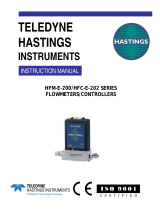 Teledyne HFM-E-200 User manual
Teledyne HFM-E-200 User manual
-
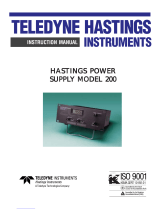 Teledyne HASTINGS 200 Series User manual
Teledyne HASTINGS 200 Series User manual
-
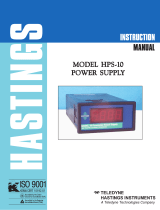 Teledyne HPS-10 User manual
Teledyne HPS-10 User manual
-
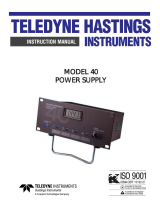 Teledyne Power Supply User manual
Teledyne Power Supply User manual
-
 Teledyne NALL User manual
Teledyne NALL User manual
-
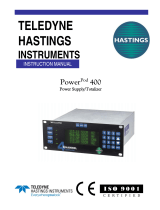 Teledyne Video Gaming Accessories powerpod 400 User manual
Teledyne Video Gaming Accessories powerpod 400 User manual
-
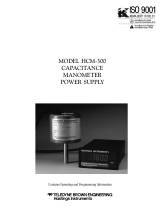 Teledyne HCM-300 User manual
Teledyne HCM-300 User manual
-
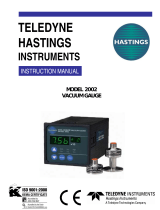 Teledyne 2002 User manual
Teledyne 2002 User manual
-
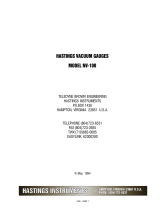 Teledyne NV-100 User manual
Teledyne NV-100 User manual
-
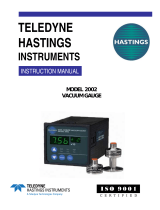 Teledyne 2002 User manual
Teledyne 2002 User manual
Other documents
-
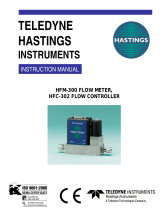 One For All HFM-300 User manual
One For All HFM-300 User manual
-
Interlogix 1038T Series Installation guide
-
Danfoss KE04107 Valve Drive Amplifier Installation guide
-
Danfoss KE04112 Valve Drive Amplifier Installation guide
-
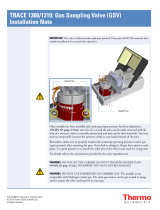 Thermo Fisher Scientific TRACE 1300/1310 Installation guide
Thermo Fisher Scientific TRACE 1300/1310 Installation guide
-
Danfoss KE04106 Valve Drive Amplifier Installation guide
-
Danfoss KE04111 Valve Drive Amplifier Installation guide
-
Danfoss KE04201 Valve Drive Amplifier Installation guide
-
Omega PX5100 Series Owner's manual
-
HP 6269A User manual










































